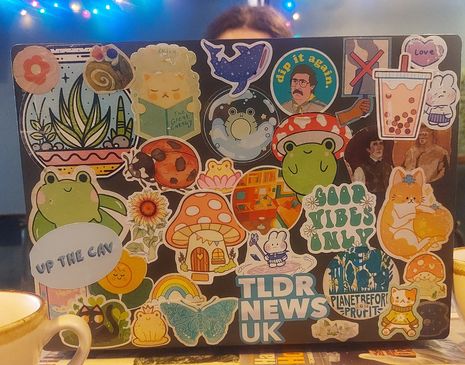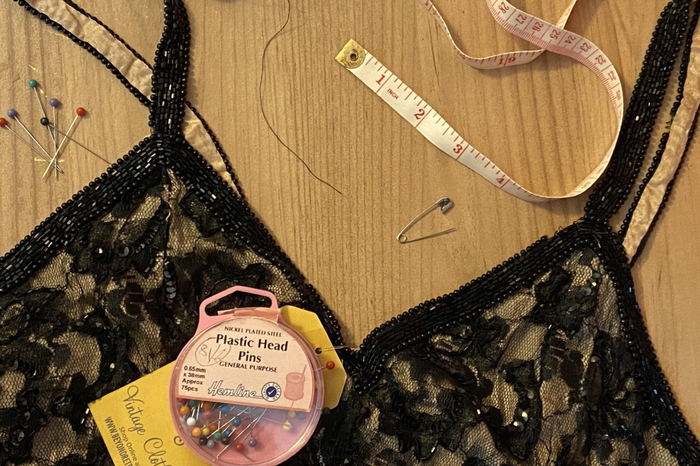Make it yours: The Politics of Personalisation
Jeanne Pétrel explores why we love to personlise….everything!

I love watching people’s laptops. I know—it’s a bit odd—but they reveal something about their owners. You’ve got the sleek, serious MacBooks with nothing but the iconic logo on display, as if to say, “Take me seriously.” Then, there are the battered old pioneers—rusty, dusty, and with years of stories etched into their scratches and dents. But my favourites are the customised ones, covered in every type of sticker: political slogans, aesthetic quotes, quirky doodles, vibrant photos, and chaotic bursts of colour. These laptops are little canvases, telling their owners’ stories in a way that is entirely unique. And laptops are just one piece of a bigger puzzle. Look around, and you’ll spot personalisation everywhere, from jewellery and tote bags to phone cases, and even nails. Who didn’t pick up a charm bracelet or necklace over the summer holidays, a nostalgic reminder of that Italian tour or lazy days tanning on a Greek island? Customisation has grown into a sort of personal storytelling—capturing pieces of our experiences and identities.
“Customisation has grown into a sort of personal storytelling—capturing pieces of our experiences and identities”
But what’s the story behind customization? Turns out, it’s been around a lot longer than we think. Go back to your great-grandmother’s era, when “customisation” meant a monogrammed handkerchief with her initials—elegant, sure, but pretty tame by today’s standards. Fast forward to the 1960s and 70s, and personalisation took on a “loud and proud” vibe, pushing peace, love, and counter-culture rebellion into mainstream view. Tie-dye took over (yes, it has roots that go way deeper than TikTok 2020) and denim jackets weren’t just denim jackets anymore; they were canvases for peace symbols, hand-painted flowers, and protest slogans. Punk rock took things up a notch. Enter The Sex Pistols, safety pins, and a whole DIY ethos that made personalisation both grungy and glamorous. Jackets adorned with metal studs, patches, and anti-establishment slogans transformed clothes from items you wear to items that speak. Customisation wasn’t just about taste—it was a visual protest, a way to make individual voices heard in the roar of consumer culture.
So maybe the next time you slap a sticker on your laptop, remember: there’s a deeper story behind that little sticky piece of paper. Customisation is more than just decoration, especially here at Cambridge where, when the wind picks up, half the city fills with students in identical college puffer jackets with college crests. In a city where academic life comes with traditions and uniforms, personalising our everyday accessories is a way to stand out. Personalising your bag, your bike basket, or your phone case is a subtle rebellion against the uniformity that often surrounds us. Each charm, sticker, and doodle quietly declares, “This is who I am,” making even a shared tradition or uniform feel personal and unique. In a sea of timeless academic gowns and historic architecture, acts of personalisation feel like little rebellions, as if quietly carving out a space for self-expression in a landscape filled with tradition.
“Personalising your bag, your bike basket, or your phone case is a subtle rebellion against the uniformity that often surrounds us”
In fact, maybe we’ll soon be customising the most traditional Cambridge item of all: our academic gowns. Imagine a small, meaningful pin on the lapel, a discreet quote stitched inside, or a touch of sparkle on the hem—just a hint of individuality on a plain black garment rooted in centuries of formality. The idea of adding personal touches to something as classic and respected as the academic gown may sound almost sacrilegious, but it’s a reminder that even in places where tradition runs deep, there’s room for individual expression.
Ultimately, personalisation is about claiming a slice of the world that feels uniquely ours. In an age of tech and mass production, where everything comes in identical versions, there’s something oddly thrilling—and comforting—about having something that feels like it was made just for you. Yes, it’s about standing out, but it’s also about weaving meaning into the everyday objects we live with. So here’s to the stickers on your laptop, the patches on your tote, and maybe, one day, even a discreet quote in your academic gown. It’s your life—make it yours.
 News / SU reluctantly registers controversial women’s soc18 December 2025
News / SU reluctantly registers controversial women’s soc18 December 2025 Features / Should I stay or should I go? Cambridge students and alumni reflect on how their memories stay with them15 December 2025
Features / Should I stay or should I go? Cambridge students and alumni reflect on how their memories stay with them15 December 2025 News / Dons warn PM about Vet School closure16 December 2025
News / Dons warn PM about Vet School closure16 December 2025 News / Cambridge study finds students learn better with notes than AI13 December 2025
News / Cambridge study finds students learn better with notes than AI13 December 2025 Comment / The magic of an eight-week term15 December 2025
Comment / The magic of an eight-week term15 December 2025









